Walking through Marietta National Cemetery or any US National Cemetery, visitors feel awed and silenced by the stunning symmetry and meticulous care for the hallowed grounds. Within these final resting places for hundreds of thousands of our nation’s protectors and heroes, glistening white headstones share small details about those who rest here below the thick carpet of dark green grass.
Scattered throughout most national cemeteries, a few larger monuments also commemorate gallant actions, tragic events and heroic moments remembered for their indelible mark on our country’s history.
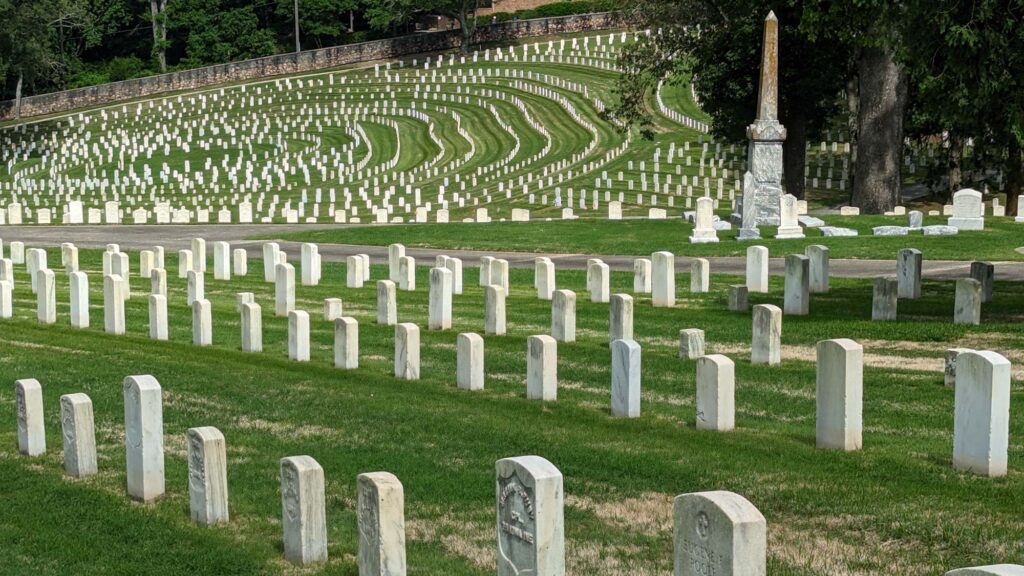
At Marietta National Cemetery, curious and intrepid visitors can find several such monuments scattered throughout the more than 18,000 gravesites. But unlike Arlington National Cemetery in Washington, DC, there are no regular tours at Marietta National to take visitors to much-visited locations. Neither are there any on-site resources available for self-guided exploration. So finding, viewing and understanding the monuments in Marietta National Cemetery takes curiosity, determination, some physical stamina and prior research.
With Memorial Day approaching, we’ve made several recent visits to Marietta National Cemetery. Following our own exploration and with help of other local resources, we’ve compiled the following information about significant monuments and individual memorials located at Marietta National Cemetery. We offer this as our personal memorial to all those who have died in service of our country on this Memorial Day. And we hope to find and share more of these stories in the future.
Marietta National’s Monuments
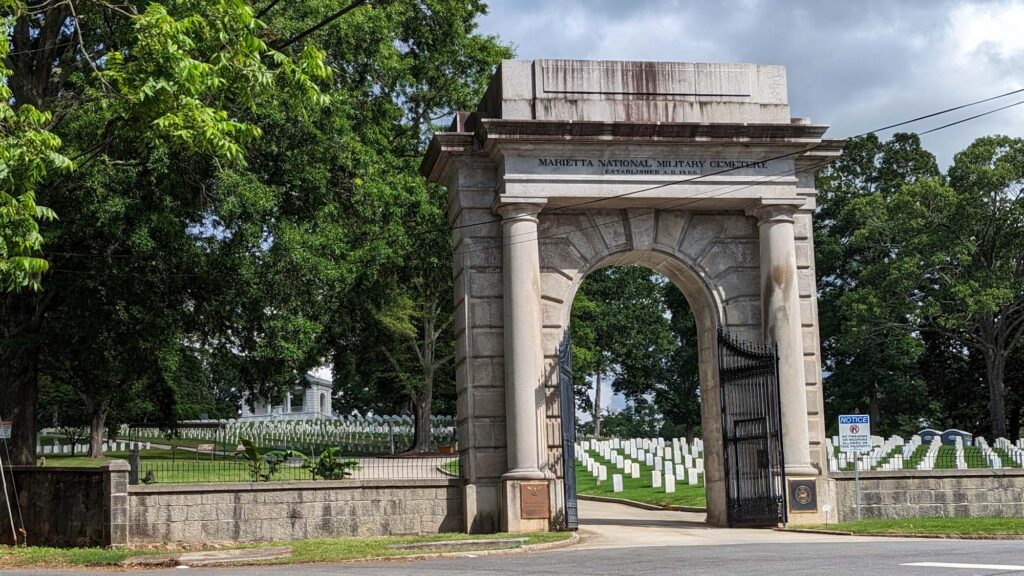
Entrance Arch. A 35-foot tall arch spans the main entrance to the cemetery at the corner of Washington and Cole Streets. It is one of five monumental masonry archways that originally served as the formal entrance to national cemeteries found in the South at Marietta; Chattanooga, TN, Nashville, TN, Arlington National Cemetery in Virginia, and Vicksburg National Cemetery in Mississippi. The Roman-inspired structures feature Doric columns, a pair of ornamental iron gates, and inscriptions above the arch. Marietta National’s inscriptions read, “Marietta National Cemetery, Established 1866,” and “Here rest the remains of 10,312 Officers and Soldiers who died in defense of the Union 1861-1865.”
Pearl Harbor Memorial. Located just inside the gate and dedicated by the Pearl Harbor Survivors Association on Dec. 7, 1996, this monument honors “those who died and those who survived the Japanese attack.” The circular monument features bricks engraved with the names of the deceased, with a headstone-shaped granite marker overlooking the space.
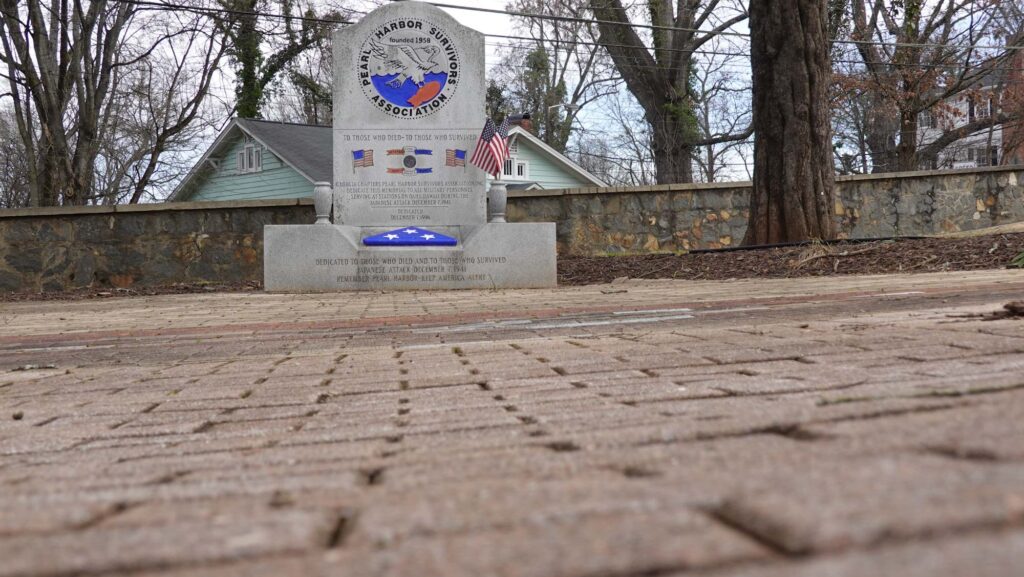
20th Army Corps Monument. A ten foot tall by two foot square obelisk located in Section B, it was erected in May 1870, only four years after the cemetery’s dedication. The monument is dedicated to the “dead heroes” of the second division of the 20th Corps, and includes a listing of battles fought by the division from Antietam in 1862 through Atlanta in 1864.
Gold Star Mother’s Monument. The Atlanta chapter of this organization donated and erected this two-foot-tall marble monument in 1960. Located near the base of the flagpole, it is inscribed: IN MEMORY OF MEMBERS OF THE ARMED FORCES OF THE UNITED STATES MISSING IN ACTION.
Rostrum. Built in 1940 in the style of Greek temples at the Acropolis, this white marble and concrete structure overlooks the cemetery from the highest hill. Three marble benches offer a peaceful location for reflection. On multiple visits, we’ve found – and left undisturbed – personal items left behind to commemorate loved ones by families visiting the cemetery. To reach the Rostrum, you’ll walk under a wisteria-covered arbor built on the remains of the original 1883 Rostrum.

Wisconsin Monument. This 12-foot tall columnar monument near the Rostrum is made of Wisconsin granite, and topped by the likeness of a badger, the Wisconsin symbol of heroic tendency. Celebrated with a huge parade and attended by more than 2,000 people, the monument was dedicated on Memorial Day 1925. With Biblical inscriptions and a listing of the Wisconsin units which fought in the Atlanta campaign, the monument honors the 405 sons of the state of Wisconsin who had perished in Georgia during the Civil War and who are interred in the cemetery.
Notable Burial Sites
Each time we visit Marietta National Cemetery, we find more sites for additional research. Following are a few of those where we’ve been able to find additional, sourced information. We’ve included links to additional information on most of these. And we continue searching for information on many others, noted at the end of this list.
Medal of Honor Sites. Two recipients of the country’s highest military honor are memorialized at Marietta. Near the flagpole in Section MB, a cenotaph honors Georgia native Marine Corporal Lee Hugh Phillips, recognized for heroic leadership in Korea. Killed in action, his remains were never recovered. In Section G, Canadian native and New York regiment member Private Dennis Buckley was awarded the Medal of Honor for his Civil War service. We did a full story on the Medal of Honor recipients.
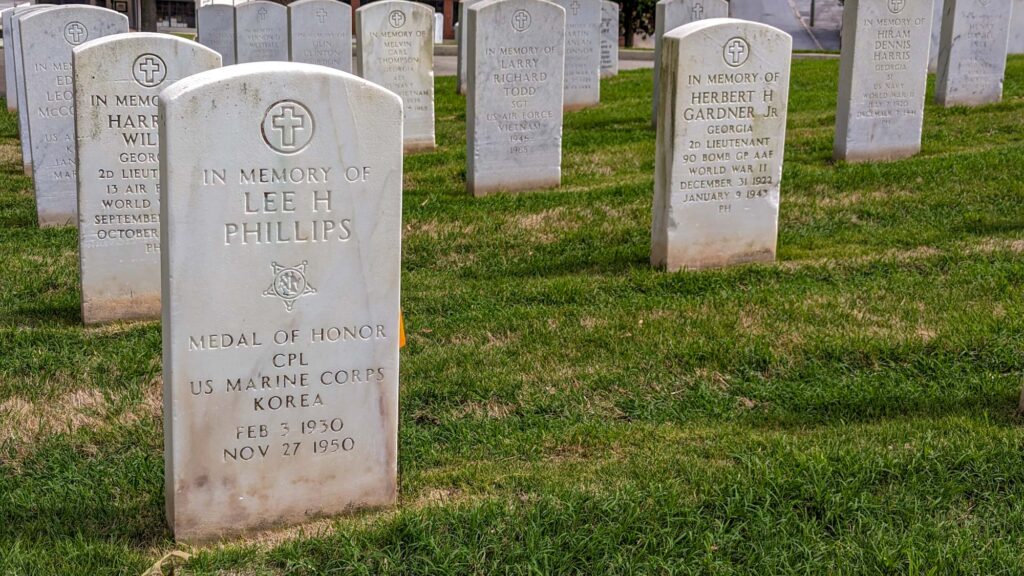
Former Georgia Governor John Clark, 1766–1832. Clark was an American Revolutionary War veteran, a US Congressman, and served as Georgia governor from 1819 to 1825. In 1825, he was defeated by 683 votes in the first governor’s election decided by popular vote of citizens. He died and was buried in Florida in 1832, then was reinterred at Marietta in May 1923 by the Daughters of the American Revolution. Clark is buried in Section D, Site 10391.
Freed Slave and Army Nurse Emma Stephenson, died 1864. As an Army nurse, Stephenson cared for wounded and ill white Union soldiers until her own death from a camp illness in July 1864. Her story was featured in a five-part series on PBS, “Civil War: The Untold Story.” She is buried in Section F, Site 4841. Also buried in Section F are 238 black Union soldiers who were killed from 1864 to 1866, some killed while patrolling Marietta after the War.
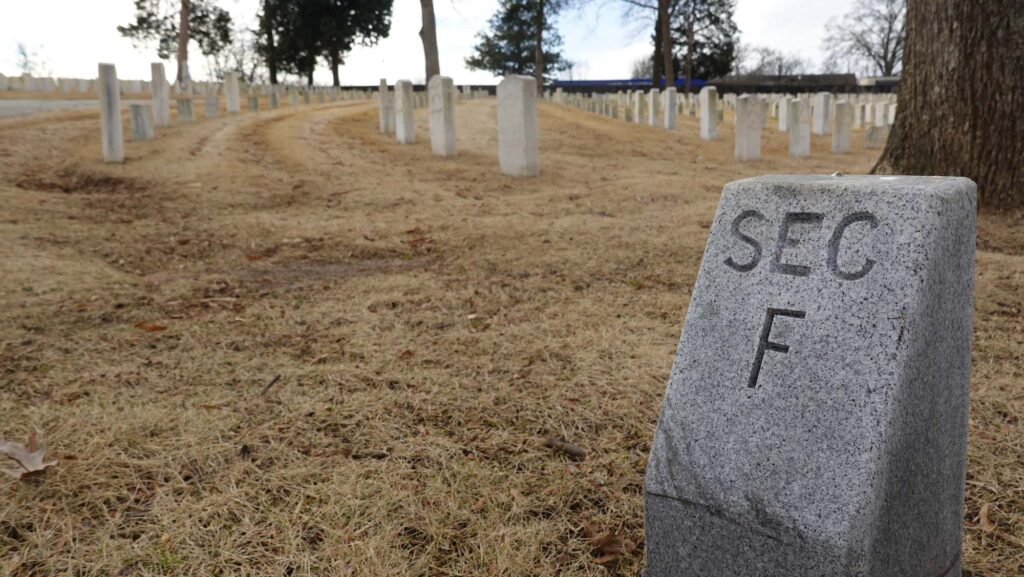
Professional Wrestler Frank Simmons Leavitt, (1891–1953). In as colorful a story as you’ll ever find, this Hell’s Kitchen, NY, native used his father’s birth records to join the Army in World War I. After serving five stints, he had a storied career as a professional wrestler, known Soldier Leavitt and eventually as Man Mountain Dean because of his huge 300-plus-pound frame. He became a movie star, was fired from a police force for being close friends with Al Capone and then rejoined the US Army during World War II. As a Master Sergeant in World War II, he was assigned to a top-secret training camp in Maryland dedicated to a counter-intelligence force comprised of immigrants from Germany, Japan and Italy. Leavitt taught deadly hand-to-hand combat techniques to the enrollees, as they also learned the art of spying. He also appeared in US Army propaganda films supporting the US war effort. Sports Illustrated did an outstanding feature on Leavitt in May 2022. Leavitt is buried in Section J, Site 9672-D.
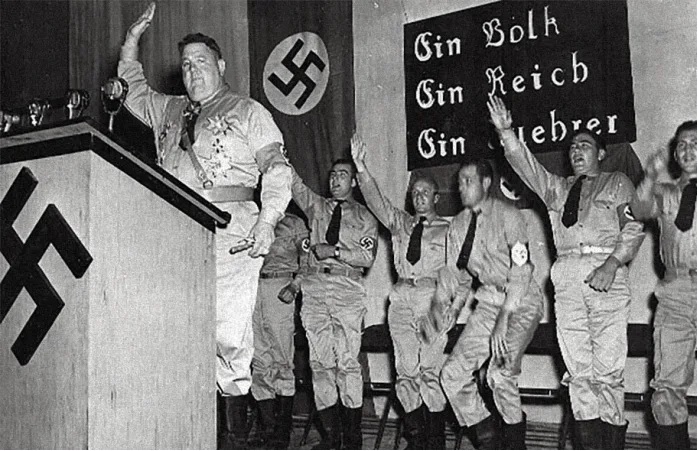
Georgia Tech President Col. Blake Van Leer (1893 –1956). Former president of Georgia Tech, and founder of Marietta’s Southern Polytechnic State University (now part of Kennesaw State). An orphan and holder of two PhDs, Col. Van Leer was in active military service in World Wars 1 and 2, earning the French Croix de Guerre for acts of heroism. He was the first engineer to serve as president of Georgia Tech and led the institution through a name change from Georgia School of Technology to Georgia Tech. Van Leer fought for, then gained approval, to admit women to the university, and also supported integration of the school. Van Leer is buried in Section A, Site 10316-D
Army Nurse, Artist and Activist Ella Lillian Wall Van Leer (1892–1986). Known as First Lady of Georgia Tech, Ella Lillian Wall Van Leer was a wartime nurse, architect, artist, and women’s rights activist. She received the US Legion of Merit for medical service in the military. Two of her map art works featuring women authors have been displayed in the Smithsonian Institute. Known as First Lady of Georgia Tech, in 2002, the Georgia Tech alumni magazine called her the “backbone of women” at the school and their “unofficial dean” for her work in overturning the statute barring female students from enrolling at Georgia Tech. Van Leer is buried with her husband, Col. Blake Van Leer, in Section A, Site 10316-C.
UGA Football and Basketball Head Coach General W. A. Cunningham (1886–1968). Cunningham became 15th head coach for UGA football in 1910. He served as head football coach for 10 years, and his 68% winning percentage is the fifth highest among all multi-year Georgia football coaches – just behind legends Vince Dooley and Mark Richt. Head football coach when World War I commenced, he joined the Army and reached the rank of general. He returned to UGA to coach one more football season, then rejoined the Army, serving through World War II. Cunningham also served as head basketball coach for two separate stints. Cunningham is buried in Section Q Site 181-C.
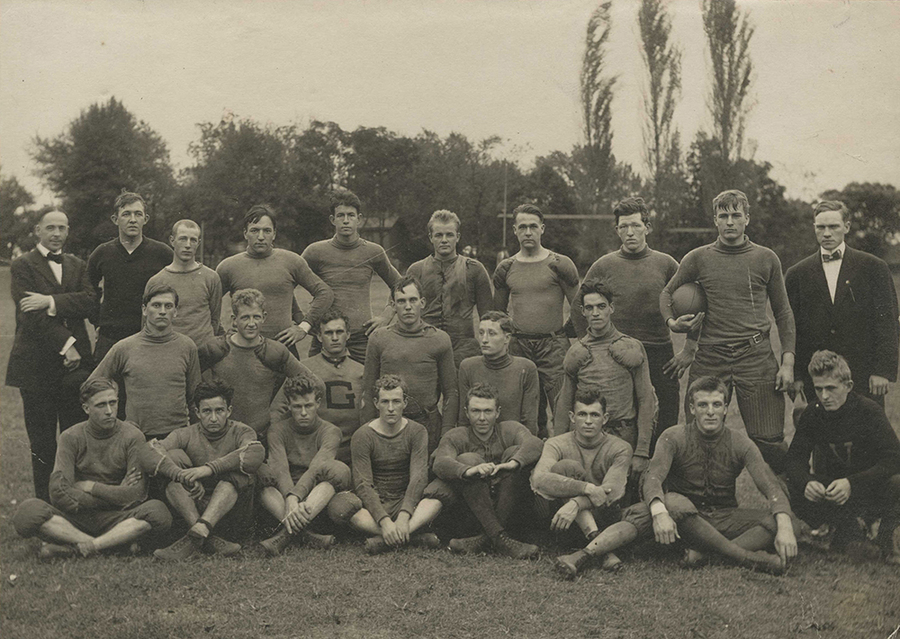
Vietnam Special Forces Member Wilford A. Phelps, (1939-1986). Lt. Col. Wilford A Phelps was a highly-decorated Vietnam veteran of US Special Forces. He received the Distinguished Service Cross, the second-highest military award behind the Medal of Honor. He also received the Silver Star with Oak Cluster, indicating he twice qualified for the nation’s third-highest military honor. His headstone lists these honors and citations: Distinguished Service Cross, Silver Star with Oakleaf Cluster, Distinguished Flying Cross, Legion of Merit, Bronze Star with Valor V, Air Medal with Valor VI, Purple Heart VI, Vietnam Medal of Honor, Vietnam Cross for Gallantry IV, and Presidential Unit Citation. But in searches of military citation databases and other records, we can find only one reference to Lt. Col. Phelps, for a Silver Star issued in 1976. The commendation reads, “for gallantry in action while engaged in military operations in the Republic of Vietnam, while serving as a member of the Special Forces (Tiger Force) Platoon, on 4 November 1966.” We’ve read many other Medal of Honor, Distinguished Service Cross and Silver Star citations which are more specific in their recounting of actions. Given his Special Forces assignment and the vague nature of this citation, this leads us to believe that many of Lt. Col. Phelps’ commendations and citations may have occurred in classified operations. Phelps is buried in Section A Site 739-A,
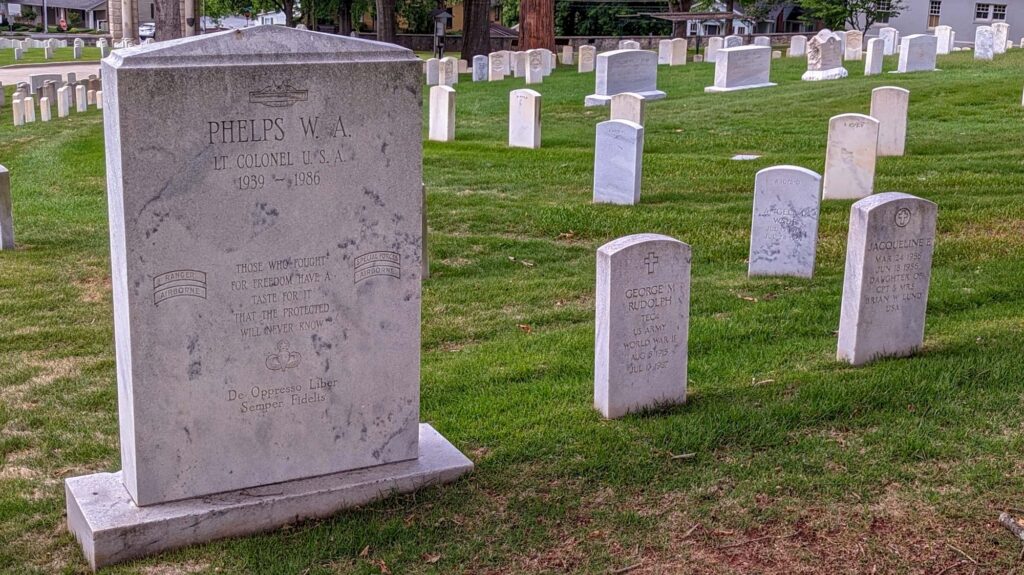
Others We’re Researching
With each visit to Marietta National Cemetery, we find additional headstones and stories that we want to research. If you have an interesting story you want to share, post it in our comments. And following is a list we’re currently researching to learn more:
Multi-War Service Personnel. We’ve discovered many dedicated service personnel who served through multiple conflict periods. These include Air Force Colonel Frederick Kuhlman and Chief Warrant Officer Thomas O. Crocker, both of whom served in World War II, Korea, Vietnam; Master Sergeant Joseph Lewis Plant, serving in World Wars I and II.
Plane Crash Victims. In Section A, a headstone remembers five members of the 29th Bomb Group of the Army Air Force who died in a plane crash on April 29, 1942. The training mission crash occurred near Tampa, FL, between a bomber and chase plane operating out of what is now McDill Air Force Base. The unusual monument to this crew is a curiosity, and we’re wondering if there’s a local connection to the Marietta Bell Bomber factory, which built the B-29 bomber.
Brig. General John William Middleton, a one-time commanding officer of the Chinese Training Center in Kunming, and also served as the President of the War Crimes Commission.





